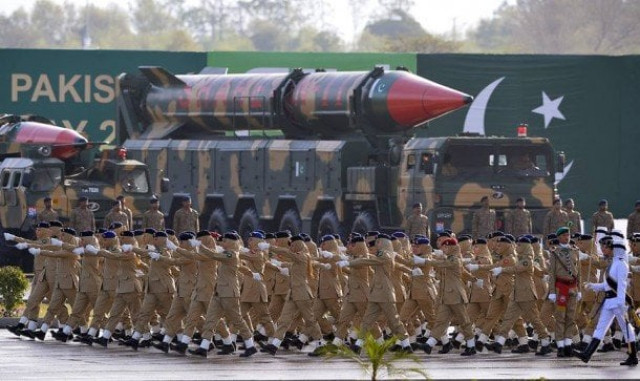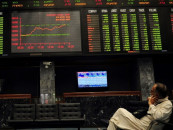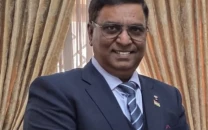Pakistan listed 9th largest arms importer in the world by SIPRI
Swedish NGO reveals country has posted a startling 36% decrease in arms procurement as it reshapes its foreign policy

PHOTO: FILE PHOTO
The non-government organisation has emphasised that the decrease in the import of weapons by Pakistan can be attributed to the country's deteriorating relationship with Washington, previously a major source of arms for Islamabad.
Global arms experts in Sweden believe the sale of weapons to the country has recently come under increased scrutiny as the global non-proliferation regime has moved to enforce international sanctions, placing certain suspect organisations and individual dealers on trading black lists.
Domestic financial constraints, triggered by an internal economic crisis, have also bitten the secretive defense sector of the nation, conflict analysts have noted.
9th largest arms importer in the world
Pakistan is the 9th largest arms importer in the world, but despite heightened tensions along the border with arch-rival India, as well as internal conflicts, the country has decreased its arms imports substantially over the past five years, the report by the non-government organisation states.
Pakistan pledged $7 billion for its armed forces this fiscal year, and purchased 2.8 per cent of all weapons sold in the world between 2013-2017, data released by the Swedish non-profit group indicates.
War, conflict fuel arms imports to Middle East, Asia, says study
However, compared to period between 2008-2012, when the country was responsible for 4.9 per cent of the total global arms imports, this represents a 36 per cent decrease in the purchase of weapons.
SIPRI has revealed that China continues to be the largest exporter of weapons to Pakistan, accounting for an astonishing 70 per cent of the total arms imports of the South Asian country. The United States of America (US) is second on the list, with a 12 per cent share in the export of weapons to the nation. The Russian Federation, which has warmed up ties with Pakistan in recent years, is third, and has a 5.7% stake in its defense sector.
Although the actual number of weapons China exports to the country has remained roughly the same over the last ten years, the Chinese share in Pakistani arms imports has jumped from 45 per cent in 2008-2012 to almost 70 per cent in 2013-2017, the report by SIPRI highlights. The non-profit group added that Pakistan also purchased air-launched cruise missiles from China in this period.
According to the Swedish organisation, the quoted increase in imports from China is due to the overall decrease in the procurement of weapons by Pakistan during the past five years.
Outlining the contribution of the US to the defense industry in Pakistan, SIPRI says that there has been a substantial decrease in US arms exports to Pakistan as successive administrations in Washington have adopted a more aggressive policy against the country to express their frustration over Islamabad's perceived lack of action against militants.
The US reduced military aid to Pakistan in 2013-2017, as the sale of American weapons to Pakistan fell by 76 per cent during this period, says the non-profit group. In contrast to the figures quoted above, from 2008-2012, the US provided substantial military aid to Pakistan, including 28 combat aircraft and 5 maritime patrol aircraft. according to SIPRI.
India
SIPRI says that India is the largest arms importer in the world, accounting for 12 per cent of the global sales. The Hindu-majority country has increased the import of weapons by at least 24 per cent during the last five years.
Australia to spend $3.1 bln to increase stake in global arms exports
Like Pakistan depends on China, India relies on Russia for the bulk of its weapons. According to SIPRI, during 2013-2017, Russia accounted for a whooping 62 per cent of arms imports to India.
But experts believe the South Asian country is seeking to diversify the sources of its arms imports, and in an effort in this regard, has inched closer to the United States.
The relationship between US and India is growing into a strategic partnership against rising superpower China, evidenced by a sky-rocketing 557 per cent increase in arms sales between India and US over the last five years. US is also supplying the Indians with advanced military equipment, SIPRI underlines.
Advanced weaponry being provided to India includes long-range maritime patrol aircraft, strategic transport aircraft and combat helicopters. Apart from these, India has bought air-launched cruise missiles from France, surface- and submarine-launched cruise missiles from Russia, and loitering munitions, commonly known as suicide drones, from Israel, SIPRI reported.
Israel is identified as the third major defense partner for the Indians, and the movement of arms from Tel Aviv to New Delhi has increased by 285 per cent between 2008–2012 and 2013–2017, according to the non-profit group.
China, United States and Russia
SIPRI lists China as the fifth biggest arms exporter in the world, and says that the country's weapons sales have increased by 38 per cent in the last five years.
According to the non-government organisation, China delivered major arms to 48 countries in 2013–2017. Pakistan was the main recipient, with a 35 per cent share, as it has been for all five-year periods since 1991. Large increases in arms supplies to Bangladesh and Algeria accounted for much of the growth in total Chinese arms exports in this period.
Interestingly, China is also the fifth largest arms importer in the world in the SIPRI report, although it has made a 19 per cent decrease in import of weapons since the 2008-2012 period. The bulk of Chinese purchases in the defense sector come from Russia, France and Ukraine.
These are the countries exporting weapons to Pakistan and India
The US was the top arms exporter in the world during 2013–2017, according to SIPRI. Its share of total arms exports globally rose from 30 per cent to 34 per cent over the past five years, as it delivered major weapons to at least 98 states in the last five years.
According to the non-profit group, states in the Middle East accounted for 49 per cent of US arms exports during this period, Saudi Arabia being the largest beneficiary with 18 per cent of total US arms exports.
SIPRI has ranked the American nation as the 14th largest importer of weaponry as well. The US imports most of its arms from North Atlantic Treat Organisation allies Germany, France and Netherlands.
The report has termed Russia the second largest arms exporter in the world, despite the fact that the exports of major weapons by the country has decreased by 7.1 per cent over the past five years. In 2013–2017, Russia delivered major weapons to 47 states, SIPRI states.
A total of 58 per cent of Russia’s arms exports went to its top three recipients: India, China and Vietnam, which accounted for 35, 12 and 10 per cent, of the total exports respectively.
Surprisingly, and unlike rival states, Russia is not on the list of the top forty global arms importers identified in the report by SIPRI.
Global trends and analysis
Conflict analysts at SIPRI have said that the volume of international transfers of major weapons in 2013-2017 was 10 per cent higher than in the preceding five years.
Trends in the released data by SIPRI indicate that the flow of arms increased to Asia and the Middle East in the past five years, perhaps as a result of heightened tensions around new conflict zones, while there was a decrease in the flow to Africa, the Americas and Europe.
The five biggest exporters - the United States, Russia, France, Germany and China - together accounted for 74 per cent of all arms exports in 2013–2017.
A range of experts have given their opinion on the SIPRI report, which can be accessed online publicly.
"The increased flow of arms raises concerns over their impact on international peace and security," Jan Eliasson, Chair of the SIPRI Governing Board, told the official website of the Swedish group. "It stresses the need to improve and implement international mechanisms such as the Arms Trade Treaty," she added.
Another expert, Pieter Wezeman, Senior Researcher with the SIPRI Arms and Military Expenditure Programme, noted in the report that the "widespread violent conflict in the Middle East and concerns about human rights have led to political debate in Western Europe and North America about restricting arms sales to these countries".
Regarding tensions between Pakistan and India in South Asia, a senior researcher with SIPRI has maintained that India's growing demands for weapons is driven by its fear of Pakistan and China, but the Hindu-majority country "remains unable to produce weapons itself".
"China, by contrast, is becoming increasingly capable of producing its own weapons and continues to strengthen its relations with Pakistan, Bangladesh and Myanmar through arms supplies," the researcher added in his assessment.



















COMMENTS
Comments are moderated and generally will be posted if they are on-topic and not abusive.
For more information, please see our Comments FAQ